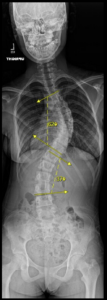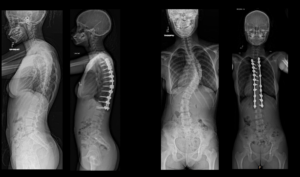“I’m in love with my back. When I saw the x-rays I was so emotional.”

Niasia first noticed her daughter Dwane was standing “funny” at a waterpark when she was 12-years-old. Niasia noted that her daughter was standing with one shoulder raised. “We looked at her back and it looked crooked,” recalled Niasia. “It just came out of nowhere.”
Niasia called her daughter’s pediatrician to find out what could be causing this curve in her daughter’s spine. A couple of referrals later, Dwane was diagnosed with progressive adolescent idiopathic scoliosis, an abnormal curvature of the spine that appears in late childhood or adolescence. Niasia insisted that Dwane’s back be fixed as soon as possible because Dwane’s scoliosis was progressing rapidly. She was referred to complex deformity and oncology spine surgeon, Dr. Michael Galgano at UNC Health.
Adolescent idiopathic scoliosis generally begins in the late pre-teen or teenager years and occurs when parts of the spinal column mal-rotate out of normal orientation. This often results in a very flat upper back known as thoracic hypo-kyphosis, and sideways curvature of the spinal column, which is known as scoliosis. Adolescent idiopathic scoliosis affects 2-3% of children in the United States. “Many adolescents we see in clinic can successfully be treated with observation alone, or with bracing for a few years if the curve magnitudes are not in the operative range,” said Dr. Galgano.
When a curve continues to increase in magnitude during the adolescent’s growth spurt, it is termed “progressive”. “If the curve magnitude reaches 50 degrees prior to the adolescent reaching maximal growth potential, there is a reasonably high likelihood that the curve will continue enlarging well into adulthood,” explained Dr. Galgano. “The spine is much more flexible in adolescents than it is in adults, so it is preferable to treat such large curves well before adulthood.”
Niasia arrived at her appointment at the UNC Spine Center hoping for treatment options. “I came with everything I needed,” said Niasia. “Images, recommendations, and I told him that I wanted it fixed because it was going to get worse.” Dr. Galgano proposed correcting the curve in her spine and confirmed that Dwane’s curve magnitude would likely progress with age, as she was still not yet done growing. “I felt like this was where I wanted to be,” said Niasia.
If left untreated and a curve reaches very large magnitudes, it can have negative reciprocal effects on other parts of the spine, and, in the most severe cases, can compromise breathing. “Large curves can also become painful, as there often is asymmetry in muscle activation of the back muscles,” said Dr. Galgano. “The lower ribs can become very pronounced and hurt as they become closer to touching the pelvis.”
Before surgery, Dwane was experiencing daily pain in her upper and lower back. Her constant back pain made it difficult to participate in cheerleading and tumbling. Sitting for long hours at school had also become extremely difficult, and she often had to stand. Her mother recalled that Dwane had to take Tylenol every day to make it through school. “The pain was really bad,” said Dwane. “It affected my cheerleading.”
Both Niasia and her daughter researched different spine surgeons online. They both felt that Dr. Galgano was the best choice. By the time she went in for surgery, Dwane’s thoracic curve was 62 degrees, and her lumbar curve was 37 degrees. She was ready to be able to stand up straight and no longer deal with constant back pain.
On April 26, 2023 Dwane arrived at UNC Health for her spine surgery. Dwane recalled that she felt “nervous, but excited” for the surgery. Her mother, Niasia described the morning going into surgery as “nerve-wracking” as she prepared to send her daughter back to the operating room for her surgery that would last 5-6 hours.
Before going back for surgery, Niasia remembers each of the doctors coming in to talk with her before taking Dwane back to the operating room. “Dr. Galgano walked us through the surgery and answered all of our questions,” said Niasia.
During the surgery, the facet joints are removed in the regions of the spine where the scoliosis is most pronounced. This “loosens” the spine so it can be straightened later in the operation. Screws are then placed in the vertebrae at the regions of spinal curvature, as well as several levels above and below the curvature. Stiff metallic rods made of cobalt chrome are then interconnected with each screw. Dr. Galgano then delivers spinal “translation and de-rotation maneuvers” to the rods in an effort to straighten the spine into the desired orientation. Dr. Galgano finished the surgery with a bone graft, using a combination of Dwane’s own bone from the removed facet joints and synthetic bone products, that overlays the spinal column in an effort to allow the spine to “fuse” in the proper orientation.

After her surgery, Dwane stayed in the hospital with her mom, Niasia, and her grandmother for five days before being discharged. Dwane recalls that the recovery was very painful for the first few days after surgery, especially the 2-hour drive home from the hospital. But about two weeks into recovery, Dwane started to turn a corner.
Dwane spent the summer taking it easy and refraining from most physical activities and sports. Despite not feeling any pain after the initial weeks of recovery, Dwane wants to be cautious for an entire year. Dr. Galgano told Niasia that it will take several months for her daughter’s back to heal from surgery.
Dwane looks forward to cheerleading again and trying other sports. She’s back at school and can sit through class without needing to stand up, and she no longer has to rely on Tylenol to get through the day.
For Dwane, the operation was worth the painful recovery immediately after surgery because of where she is today. “I think everything was worth it,” said Dwane. I’m in love with my back. When I saw the x-rays I was so emotional.” Niasia agrees that her daughter’s surgery was worth it. “We don’t regret anything and we would definitely do it again.”
Written by: Makenzie Hardy, Marketing Coordinator, UNC Health Department of Neurosurgery